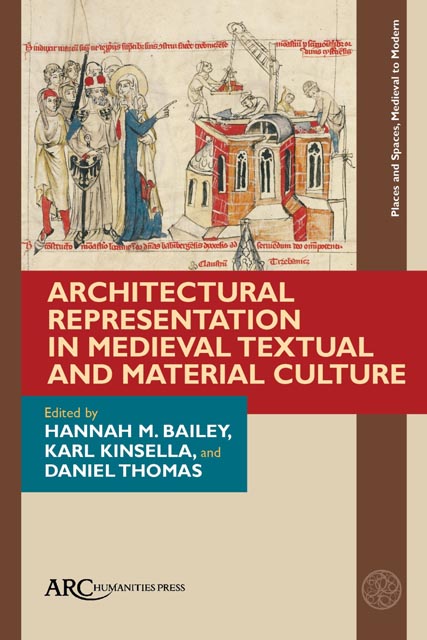Book contents
- Frontmatter
- Contents
- List of Illustrations
- Acknowledgements
- Introduction: Architectural Representation in Medieval Textual and Material Culture
- Chapter 1 Designing the Regensburg Spire and Harburg Tabernacle: The Geometries of Two Great German Gothic Drawings
- Chapter 2 Wilfrid’s Restoration of the Church at York and the Permanence of Sacred Buildings in Post-Conversion Northumbria
- Chapter 3 Heaven-Roofs and Holy Altars: Envisioning a Seventh-Century English Church in Aldhelm’s Carmina Ecclesiastica 3
- Chapter 4 “Beaten Down and Built Anew”: Saint Erkenwald and Old St. Paul’s
- Chapter 5 Castle Viewscapes in Literature and Landscapes
- Chapter 6 Architectural Alignment in Early Medieval English Settlements: Zoning, Meaning, and Function
- Chapter 7 Underneath the Arches: Peter of Eboli and the Orderly Architecture of Norman Sicily
- Chapter 8 Reading the Saint’s Church: A Northern Perspective
- Select Bibliography
- Index
Chapter 8 - Reading the Saint’s Church: A Northern Perspective
Published online by Cambridge University Press: 16 November 2023
- Frontmatter
- Contents
- List of Illustrations
- Acknowledgements
- Introduction: Architectural Representation in Medieval Textual and Material Culture
- Chapter 1 Designing the Regensburg Spire and Harburg Tabernacle: The Geometries of Two Great German Gothic Drawings
- Chapter 2 Wilfrid’s Restoration of the Church at York and the Permanence of Sacred Buildings in Post-Conversion Northumbria
- Chapter 3 Heaven-Roofs and Holy Altars: Envisioning a Seventh-Century English Church in Aldhelm’s Carmina Ecclesiastica 3
- Chapter 4 “Beaten Down and Built Anew”: Saint Erkenwald and Old St. Paul’s
- Chapter 5 Castle Viewscapes in Literature and Landscapes
- Chapter 6 Architectural Alignment in Early Medieval English Settlements: Zoning, Meaning, and Function
- Chapter 7 Underneath the Arches: Peter of Eboli and the Orderly Architecture of Norman Sicily
- Chapter 8 Reading the Saint’s Church: A Northern Perspective
- Select Bibliography
- Index
Summary
In my 2003 book, Castles of the Mind: A Study of Medieval Architectural Allegory, I explored a long-running patristic and scholastic tradition of architectural allegory, and traced the way that biblical architectures such as the temple, tabernacle, and ark were systematically allegorized as the body of Christ, that is, as the Christian church, in commentaries and treatises such as Gregory the Great's Homiliae in Ezechielem, Bede's De Templo and De Tabernaculo, Richard of Saint-Victor's Benjamin Major (an allegorization of the Ark of the Covenant), Hugh of Saint-Victor's De Arca Noe Morali and De Arca Noe Mystica, and Robert Grosseteste's De Templum Dei. Typically, in these exegeses, the length of the temple was equated with the dimension of time and with the progression of the church through salvation history, the breadth with the sum of believers, and the height with the volumes of scripture. The Old Testament building became an imaginative diagram summing up Christian doctrine and all who lived in accordance with it, through God's temporality. It was a closed, intact, unambiguous figure. In the twelfth and thirteenth centuries, a very similar allegorical process was applied to the contemporary church edifice by a series of high-ranking ecclesiastics: Honorius Augustodunensis (1080–ca.1140), John Beleth (fl. 1182?), Sicardus of Cremona (1155–1215), Pope Innocent III (1161–1216), and most famously Durandus, bishop of Mende (1230–96). In their liturgical and eucharistic manuals, the walls, roof, columns, pavement, and portals of the church were interpreted as symbols of the people and beliefs that made up the Christian ideology. Hence, the portal was Christ, the door into Christian belief, while the internal columns of the church were its bishops who supported the superstructure of the faith. In addition, extensive allegorical attention was given to the offices enacted in the church and the furnishings it contained: its altars, candlesticks, images, sanctuary spaces, and the priest's vestments. The aim of these manuals was to explain the inner significance of liturgical performance and practice to the clergy, and also to deepen the mystery of the mass. The contemporary church building became a kind of scripture in and of itself: subjected to the same four-fold process of exegesis as the scriptural text and as scriptural architecture.
- Type
- Chapter
- Information
- Publisher: Amsterdam University PressPrint publication year: 2023



